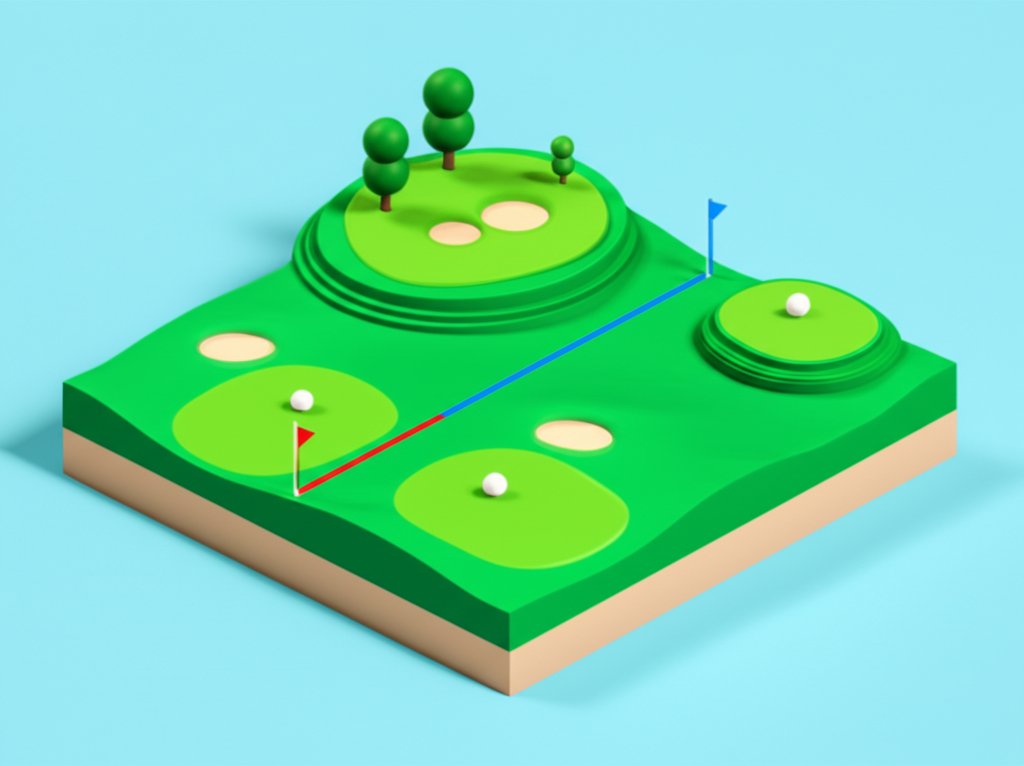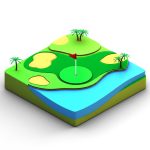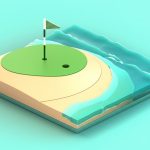Ever wonder what truly separates a good golfer from a great one? It’s often the meticulous understanding of distance for every golf club in their bag. This isn’t just about raw power; it’s about precision, strategy, and confidence – the hallmarks of superior course management. Knowing your yardages transforms guesswork into calculated decisions, leading to fewer missed greens, more consistent approaches, and ultimately, lower scores. This comprehensive guide, backed by insights from the PGA and LPGA Tours, will demystify average club distances, illuminate the critical factors influencing your shots, and provide actionable strategies to enhance your game.
To learn even more, consider this helpful resource on golf club distances.
Key Insights for Every Golfer:
- Precision is Power: Mastering your club distances is a secret weapon, enabling smarter club selection and significantly improving your score.
- Factors at Play: Your unique swing speed, smash factor (the efficiency of energy transfer), club loft, and even external elements like weather and altitude critically influence how far the ball travels.
- Benchmarks Matter: While individual results vary, understanding average distances across different skill levels and genders provides crucial context for personal improvement and effective practice.
- Measure Accurately: Utilize technology and smart practice methods to precisely determine your unique carry and total distances for each club.
- Optimize Everything: From your physical fitness and equipment setup to your ball choice, every detail contributes to maximizing your distance and consistency.
Your Ultimate Guide: Average Golf Club Distances
To truly master club selection, it’s essential to benchmark your distances against established averages. The following comprehensive table compiles data across various skill levels and gender, providing a robust reference for your game. Remember, these figures primarily represent average carry distances in yards—the distance the ball travels in the air before hitting the ground. Total distance includes any roll after landing. Your personal results will vary based on your unique swing characteristics and playing conditions.
| Club | Male Pro (PGA Tour) | 15 HCP Male (Average Amateur) | Female Pro (LPGA Tour) | Female Am (Average Amateur) |
|---|---|---|---|---|
| Driver | 303 | 236 | 260 | 190 |
| 3-Wood | 273 | 215 | 226 | 170 |
| 5-Wood | 259 | 215 | 200 | N/A |
| 7-Wood | 210 | N/A | 195 | N/A |
| 3-Hybrid | 197 | 170 | 160 | N/A |
| 4-Hybrid | N/A | 160 | 170 | N/A |
| 2-Iron | 210 | N/A | 175 | N/A |
| 3-Iron | 238 | 155 | 180 | N/A |
| 4-Iron | 228 | 186 | 185 | 150 |
| 5-Iron | 218 | 169 | 174 | 140 |
| 6-Iron | 216 | 162 | 163 | 130 |
| 7-Iron | 194 | 154 | 153 | 120 |
| 8-Iron | 180 | 146 | 142 | 110 |
| 9-Iron | 166 | 136 | 131 | 100 |
| Pitching Wedge (PW) | 153 | 121 | 120 | 85 |
| Gap Wedge (GW) | N/A | 105 | N/A | 70 |
| Sand Wedge (SW) | N/A | 90 | N/A | 60 |
| Lob Wedge (LW) | N/A | 75 | N/A | 50 |
N/A indicates data not explicitly available for that specific club and skill level across widely published averages. Data is presented in yards.
Important Note on Amateur Data: There’s a significant gap in skill and swing speeds among amateur golfers. While professional data from TrackMan and Shot Scope is highly accurate, good large-sample data for amateurs is harder to come by. The amateur figures above are derived from limited available data and observations across a wide range of players.
The Science of Flight: Key Factors Influencing Golf Club Distance

Distance in golf isn’t solely about brute strength; it’s a dynamic interplay of several key elements. Understanding these factors is fundamental to unlocking your full potential and optimizing your golf performance.
1. Swing Speed: The Distance Multiplier
How much power are you generating? Your golf swing speed is arguably the most dominant variable, directly correlated with how far your ball travels. The faster your clubhead travels through impact, the greater the potential for ball speed and, consequently, distance. This impact is particularly evident in iron distances and wedge distances. TrackMan data illustrates this relationship for amateur golfers’ driver carry distances:
- 80 mph Swing Speed: Expect a carry of 180-200 yards.
- 90 mph Swing Speed: Your carry should fall in the 200-220 yard range.
- 100 mph Swing Speed: Look for carry distances between 220-240 yards.
- 110 mph Swing Speed: Drives will likely carry around 240-260 yards.
- 120 mph Swing Speed: You’re reaching advanced distances, achieving carry distances of 260+ yards.
For context, PGA Tour players, with an average driver swing speed of approximately 115 mph, achieve an average driving distance of around 293.9 yards. LPGA Tour players, with an average driver swing speed closer to 96 mph, see their drives travel about 240 yards on average. This stark contrast highlights the direct correlation between swing speed and driving distance.
2. Smash Factor: Refining Impact Efficiency
Speed alone isn’t enough. Smash factor, a measure of how efficiently you transfer energy from the clubface to the ball, determines the quality of that speed. It’s calculated by dividing the ball speed by the clubhead speed. A higher smash factor (ideally closer to 1.5, meaning 1.5 times ball speed compared to clubhead speed for a driver) indicates a more centered impact and efficient energy transfer. A low smash factor, even with high swing speed, means yards are being left on the table due to off-center strikes.
3. Club Specifications: Loft, Length, and Design
Beyond your swing, the loft (angle of the clubface) and length of the club are meticulously engineered to produce specific trajectories and distances. A lower lofted driver is designed for maximum distance, while higher lofted wedges are for precision around the green.
- Loft: Each club’s loft is meticulously designed to optimize launch angle and spin for its intended distance. Too much or too little loft for your swing can lead to inefficient ball flight.
- Length: A longer shaft can generate more clubhead speed but also makes it harder to hit the sweet spot consistently. The right length is crucial for both speed and accuracy.
- Flex: The stiffness of your club’s shaft (flex) must match your swing speed. An incorrect flex can lead to a loss of control, distance, and feel.
4. Ball Flight Dynamics: Launch Angle and Spin
For each club, there is an optimal amount of spin and an optimal launch angle. Launch angle is the angle of a golf ball’s initial ascent relative to the ground. Launching the ball too high or too low will cost you distance. Similarly, too much or too little spin will drastically affect carry and roll.
Problems with spin and launch are often caused by the club face being aimed too open or too closed relative to the club path upon impact. This can lead to both too much spin and the ball’s spin axis being too strongly left-to-right (slice) or right-to-left (hook). If your club face is open (aimed right) relative to your club path, this can cause excessive left-to-right spin, leading to a significant loss of yards from a slice.
5. Environmental Factors: Weather and Altitude
There are also factors out of your control that can significantly affect distance, like temperature and altitude.
- Temperature: Air density decreases with rising temperatures. Every 10 degrees Fahrenheit that the temperature rises can easily lead to a couple of yards of additional ball flight with a driver due to less air resistance.
- Altitude: Similarly, higher altitudes mean less dense air, reducing drag on the ball. If you drive the ball 240 yards at sea level, you will carry it around 255 yards in Denver’s mile-high altitude.
- Wind: Headwinds will drastically reduce carry distance, while tailwinds can add significant yardage. Crosswinds will impact the ball’s trajectory, requiring adjustments in aim.
- Course Conditions: Firm fairways will allow for more roll-out, increasing total distance, while soft, wet conditions will absorb impact, reducing roll.
Measure What Matters: Pinpointing Your Club Distances

Knowing your average distances for each club is paramount for strategic play. Here’s how to accurately determine your numbers:
1. Utilize Technology for Precision
- Golf Simulator or Launch Monitor: Devices like TrackMan, Foresight Sports GCQuad, SkyTrak, and even more affordable options like the Rapsodo MLM or PRGR Launch Monitor (around $200) provide highly accurate data on carry distance, total distance, clubhead speed, ball speed, launch angle, spin rates, and smash factor. Many indoor facilities offer simulator rentals if you don’t own one.
- Golf Tracker Systems: Wearable or club-mounted sensors like Arccos Caddie automatically track your shots on the course, providing real-time data and post-round analysis of your average distances for each club.
2. Manual Measurement for Practical Data
- Driving Range with a Rangefinder: While less precise than a launch monitor, you can get good estimates. Go to a range with clear distance markings. Hit 5-10 balls with each club, focusing on consistent, solid contact. Use a rangefinder to measure the yardage to where the balls land, ignoring outliers. Find the average for each club.
- Crucial Tip for Range Practice: Be aware that many golf ranges use cheap, inconsistent, or even “limited flight” balls specifically designed not to fly as far as normal golf balls. Your typical range ball can easily cost you 10+ yards with the driver, while a limited flight range ball can lose you 30+ yards of distance compared to a premium golf ball. Always use the same type of golf ball you play on the course for the most accurate measurements.
3. Create Your Personal Distance Chart
Once you have your data, create your own club distance card to keep in your golf bag or on your phone. This quick reference tool will be invaluable on the course, helping you make confident club choices. For optimal accuracy, track both carry and total distances.
Elevate Your Game: Strategies to Improve Your Distances
Beyond simply knowing your numbers, actively working to improve your distance and consistency can transform your game.
1. Optimize Your Physical Fitness
Is your body ready for the challenge? A golf-specific fitness routine can notably improve your distance potential by enhancing power, stability, and flexibility.
- Strengthen Your Core: A powerful core provides the stable base needed to generate rotational speed and transfer power efficiently from your lower body to your clubhead.
- Engage in Rotational Exercises: Improve your body’s ability to turn and create torque through the swing, which is vital for a dynamic, powerful swing. Focus on exercises that mimic the golf swing’s rotational demands.
- Enhance Flexibility: A greater range of motion, particularly in the hips, shoulders, and spine, allows for a fuller swing arc and less restricted movement, promoting increased clubhead speed and reducing injury risk.
- Improve Cardiovascular Endurance: Maintain energy and focus throughout your round, especially crucial on the back nine when fatigue can impact swing quality, leading to lost distance and accuracy.
2. Fine-Tune Your Equipment
Are your clubs truly fitted to your game? Equipment optimization is a critical, often overlooked, component of distance gains and consistency.
- Dial in Driver Loft: Work with a professional club-fitter to find the optimal loft for your driver, maximizing launch angle and minimizing excessive spin for ultimate carry and roll.
- Select the Correct Shaft Flex: Match your shaft stiffness to your swing speed. An appropriately flexible shaft enhances control and optimizes power transfer. A shaft that is too stiff or too flexible will hinder performance.
- Assess Optimal Club Length: Ensure your clubs are the right length for your height and posture. Correct club length promotes consistent and centered contact, which is vital for smash factor.
- Choose the Right Golf Ball: Select a ball designed to complement your swing speed and desired flight characteristics for maximum distance, feel, and control. Different balls offer different spin rates and compression, impacting your total distance.
3. Strategic Practice and Feedback
How do you make these improvements stick? Deliberate practice, guided by objective data, is key to sustained distance gains and enhanced consistency.
- Focus on Swing Mechanics: Work with a PGA professional to refine your swing path, clubface angle at impact, and body rotation. Small adjustments can lead to significant gains in clubhead speed and smash factor.
- Use Feedback Tools: Regularly use launch monitors or simulators during practice sessions. The immediate feedback on ball speed, clubhead speed, launch, and spin is invaluable for making targeted improvements.
- Practice with Purpose: Don’t just hit balls. Practice specific shots, maintain consistent tempo, and track your progress. Focus on hitting the sweet spot and maintaining consistent distance gaps––ideally 8-10 yards between irons––for superior precision.
- Short Game Improvement: While this guide focuses on distance, remember that a strong short game complements precise iron play. Improving your wedge distances and control around the green will further lower your scores.
Conclusion: Master Your Distances, Master Your Game
Understanding and optimizing distance for every golf club is a continuous journey that will significantly elevate your golf performance. By knowing your numbers, comprehending the scientific factors at play, and implementing strategic improvements in your fitness, equipment, and practice, you transform guesswork into informed decisions. Embrace the data, commit to the process, and watch as your confidence soars and your scores plummet. The path to becoming a better golfer begins with mastering your distances.
- Unforgettable: Talking Stick Golf Club Review – Desert Golfing Redefined - November 17, 2025
- Discover Talega Golf Club: Championship Golf & Spanish Hospitality Awaits! - November 15, 2025
- Is Strawberry Farms Golf Club Orange County’s Best Kept Secret? - November 13, 2025









